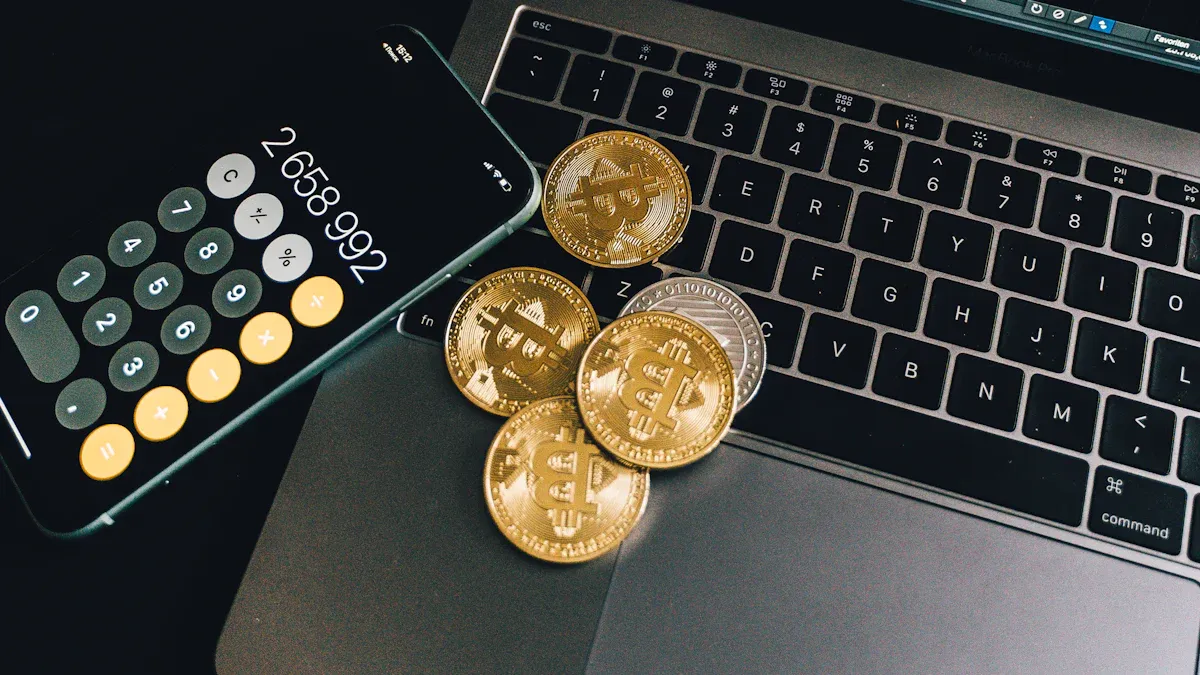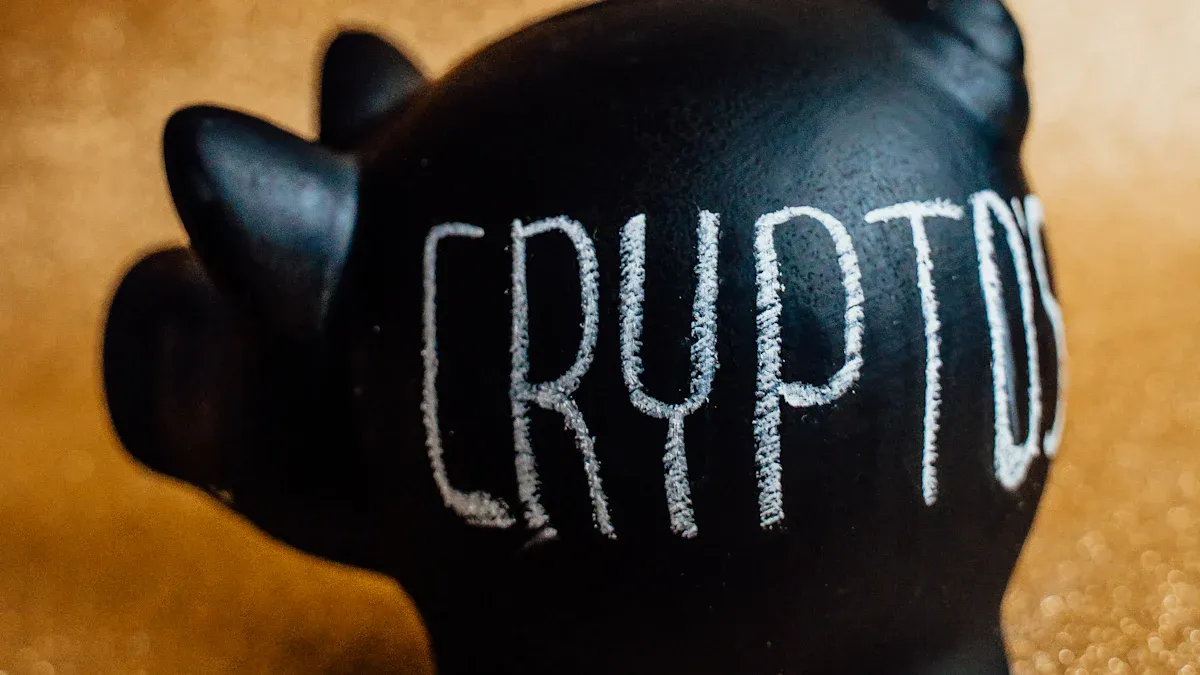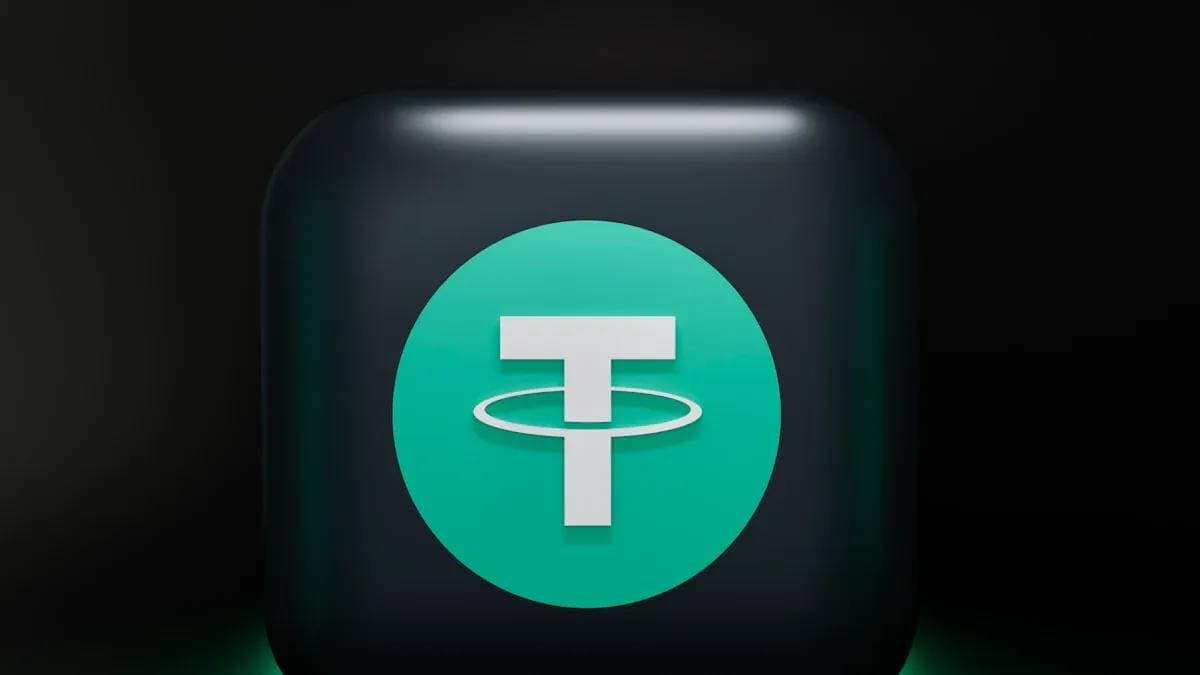- EasyCard
- Trade
- Help
- Announcement
- Academy
- SWIFT Code
- Iban Number
- Referral
- Customer Service
- Blog
- Creator
Mind-Blowing: USDT for International Trade Settlement is 99% Faster Than Wire Transfers

Image Source: unsplash
For many international trade companies, using USDT for settlement can be up to 99% faster than traditional bank wire transfers and significantly reduce your capital costs. You may still be waiting 1 to 5 business days for a payment, which is the norm for traditional settlement methods.
The efficiency of USDT stems from its technological foundation. It is based on blockchain, enabling peer-to-peer value transfer. This process bypasses the complex network of intermediary banks in the traditional financial system, thereby eliminating time delays and multiple fees.
This means your funds can arrive in minutes, not days.
Key Takeaways
- USDT settlement is much faster than traditional wire transfers, saving 99% of the time, with lower fees.
- To use USDT for international trade settlement, you need to open a digital wallet first, then receive USDT, and finally convert it into local currency.
- USDT settlement involves risks such as market volatility, operational errors, counterparty fraud, and legal compliance.
- In mainland China, using USDT for large transactions may violate foreign exchange regulations; be sure to consult professionals.
- Choose the TRC20 network for USDT transfers—it offers fast speed and low fees.
USDT vs. Wire Transfer: Quantified Comparison of Speed and Cost

Image Source: pexels
When you delve into the operational details of the two settlement methods, the significant advantages of USDT in efficiency and cost become clear. Let’s quantify this efficiency revolution with data.
Speed Comparison: Why 99% Faster?
The speed bottleneck of traditional wire transfers lies in its “relay-style” clearing network. A cross-border remittance typically goes through the following steps:
- Your bank processes the remittance request.
- Funds enter one or more intermediary banks for routing.
- Finally arrive at your client’s bank.
This process involves multiple institutions, banking systems in different countries, and manual reviews. It is severely affected by banking hours, holidays, and time zone differences, resulting in a remittance usually taking 1 to 5 business days to complete.
How does USDT achieve disruption? USDT operates on blockchain, enabling peer-to-peer value transfer. Your transfer does not require any intermediary banks and is sent directly from your digital wallet to your client’s digital wallet. The entire process is automated and runs 7x24 hours without interruption.
Let’s look at specific transfer times:
| Blockchain Network | Estimated USDT Transfer Time |
|---|---|
| TRC20 (TRON) | Usually less than 1 minute |
| ERC20 (Ethereum) | About 5-10 minutes (may be extended during network congestion) |
Taking the commonly used TRC20 network as an example, transaction confirmation only takes 3-5 seconds. Even including platform processing time, your client can receive funds in minutes. Compared to the average 3 business days (about 4320 minutes) wait for wire transfers, USDT arrives in 5 minutes, reducing time by over 99%. This means you can confirm receipt faster, arrange shipments, and accelerate the entire trade cycle.
Cost Comparison: Where Exactly Are the Savings?
The cost structure of traditional wire transfers is complex and opaque, often including “hidden fees” that are not easily noticeable.
- Bankhandling fees: Your sending bank charges a fixed transaction fee.
- Cable fees: Fees incurred for sending messages via the SWIFT network.
- Intermediary bank fees: This is the biggest uncertain cost. Each intermediary bank may charge a processing fee of $15 to $50.
- Exchange rate loss: When banks perform currency conversion, the exchange rate provided usually includes a 1-3% spread. This is the bank’s profit source and your largest hidden cost.
In contrast, the cost structure of USDT is extremely simple and transparent:
- On-chain transfer fee (Gas Fee): The fee paid to network miners when transferring on the blockchain. This fee is very low, especially on the TRC20 network. During non-peak periods, transfer costs are usually less than $2.
- OTC deposit/withdrawal service fee: When you or your client need to convert USDT to local fiat currency, over-the-counter (OTC) platforms charge a service fee. For large transactions, this fee is usually far below 1%.
Case Calculation: Cost Breakdown for a $100,000 Payment
Now, let’s calculate the total cost of a $100,000 payment using the two international trade settlement methods through a specific case.
Scenario: You need to collect a $100,000 payment from an overseas client.
| Cost Item | Traditional Bank Wire Transfer (Estimate) | USDT Settlement (TRC20 Network) |
|---|---|---|
| Bank/Platform Handling Fee | $25 (sending bank) | - |
| Intermediary Bank Fee | $25 (assuming only one) | - |
| Cable Fee | $15 | - |
| On-chain Transfer Fee (Gas Fee) | - | $2 |
| Exchange/Conversion Cost | $1,500 (calculated at 1.5% exchange rate loss) | $300 (calculated at 0.3% OTC service fee) |
| Total Cost | About $1,565 | About $302 |
| Arrival Time | 1-5 business days | About 5 minutes |
Through this cost breakdown, you can clearly see that processing the same $100,000 payment using USDT settlement can save you over $1,200 in direct costs, with a vastly different fund arrival speed. This saved money, whether reinvested in production or kept as profit, will substantially enhance your company’s competitiveness.
USDT International Trade Settlement: Three-Step Operation Guide
After understanding the advantages of USDT in speed and cost, you may wonder how to apply it to actual business. The process is simpler than you think. However, before diving into the steps, we need to objectively view its current application in real commercial environments.
Taking “the world’s supermarket” Yiwu as an example, although some reports claim that certain merchants use USDT to improve efficiency, the on-ground situation is more complex. Many merchants are unaware of it or take a cautious approach, preferring traditional wire transfers or compliant third-party payment platforms. This indicates that USDT, as an emerging tool, still faces challenges in widespread adoption.
Nevertheless, for companies eager to embrace new technology, mastering the following three steps will start your efficient USDT international trade settlement journey.
Step 1: Open a Wallet and Choose a Platform
Your first step is to set up a digital “account” for receiving and managing USDT. You have two main options:
- Non-Custodial Wallet: You fully control the private keys and have absolute ownership of assets. Suitable for users with extremely high security requirements.
- Comprehensive Trading Platform (Custodial Platform): Platforms like Biyapay integrate wallet, trading, and OTC deposit/withdrawal functions, offering more convenient operations and suitable for beginners.
When choosing a non-custodial wallet, you can refer to the following highly rated options:
| Wallet Name | Main Advantages |
|---|---|
| MetaMask | The most popular Ethereum wallet, widely supporting various decentralized applications. |
| Trust Wallet | Supports over 35 blockchain networks, user-friendly interface, owned by Binance. |
| Coinomi | Supports over 125 networks, considered one of the best wallets for managing USDT. |
When selecting a trading platform, be sure to examine its security measures, such as whether it provides two-factor authentication (2FA), cold storage for funds, and advanced fraud detection tools, to protect your assets.
Step 2: Receive USDT Payment
When you are ready to receive USDT payments from clients, the process is very straightforward. You simply provide the payer with your receiving address.
The operation steps are as follows:
- Log in to your wallet or trading platform account.
- Find the “Deposit” or “Receive” function.
- Select the currency USDT and choose the correct blockchain network.
Important Tip: It is strongly recommended to agree with the client to use the TRC20 (TRON) network. Its transfer fees are extremely low (usually less than $2) and speed is the fastest. Ensure that the address you provide matches the network chosen by the client during transfer; otherwise, funds will be permanently lost.
- Copy your USDT receiving address or display the QR code and send it to your client.
After the client completes the transfer, you will usually see the payment in your account within minutes.
Step 3: Convert to Local Fiat Currency
After receiving the USDT payment, the final step is to convert it to the local fiat currency you need, such as USD. The most common method is through the platform’s over-the-counter (OTC) or P2P (peer-to-peer) market.
This process is generally as follows:
- In the platform’s P2P/OTC trading area, select “Sell USDT”.
- Filter for buyers with good reputation and suitable prices, and confirm they support your receiving method.
- Enter the amount of USDT you wish to sell; the platform will escrow and lock this portion of assets.
- Wait for the buyer to pay to your designated bank account (e.g., an account opened at a licensed bank in Hong Kong).
- After confirming receipt of the full amount, click “Confirm Receipt and Release” on the platform; the platform will release the escrowed USDT to the buyer.
At this point, you have completed a full USDT receipt and conversion process.
Risks and Compliance: Challenges That Cannot Be Ignored

Image Source: pexels
Although USDT demonstrates significant advantages in efficiency and cost, this convenience comes at a price. Before deciding to incorporate it into your business processes, you must clearly recognize and assess the accompanying risks. These challenges not only concern fund security but directly impact your company’s compliance lifeline.
Four Major Risks: Market, Operational, Counterparty, and Legal
When engaging in USDT settlement, you are navigating a new financial ecosystem. You need to be vigilant about potential risks from four dimensions.
- Market Risk: Although USDT is called a “stablecoin,” its value is not absolutely constant. Its stability pegged to the USD depends on the issuer Tether’s reserve conditions and market confidence. Although historical data shows its volatility is far lower than other crypto assets, under extreme market conditions, it may still experience de-pegging, leading to short-term asset value discounts.
- Operational Risk: Blockchain transactions are irreversible. Once you send USDT to the wrong address, the funds are almost impossible to recover. Unlike bank transfers, there is no customer service to help reverse the transaction. A small input error can lead to permanent loss of all funds.
- Counterparty Risk: When converting USDT to fiat through P2P/OTC platforms, you are trading with strangers. This harbors fraud risks.
Common P2P Fraud Methods
- Forged Payment Proof: Scammers send you a forged bank transfer screenshot, urging you to release USDT before confirming actual receipt.
- Payment Reversal/Refund: The counterparty uses payment methods that allow reversal (such as checks) to pay you. After you release USDT, they apply to the bank for reversal or report fraud to recover funds.
- SMS Scam: You may receive a fake bank notification SMS falsely informing you of receipt, inducing you to release assets prematurely.
- Legal Risk: This is the most severe challenge. In many countries and regions, using cryptocurrency for large transactions, especially bypassing traditional financial systems, may cross legal red lines.
- In mainland China, using USDT and other virtual currencies as a medium to achieve illegal exchange between RMB and foreign currency may be identified as “disguised foreign exchange trading.”
- According to public court judgments, individuals have been held criminally liable for using USDT transactions to evade foreign exchange controls, involving huge amounts, and ultimately sentenced to imprisonment.
- The court ruled that such behavior violates China’s Anti-Money Laundering Law and Foreign Exchange Management Regulations.
Core Challenge: Foreign Exchange Controls and Compliance Paths
For companies engaged in international trade, the core challenge is how to enjoy the convenience of USDT without crossing foreign exchange control red lines. Directly using USDT for payment settlement and privately converting to local fiat carries huge compliance risks in most cases.
So, is there a relatively compliant path? The answer lies in embracing regulation.
Some companies choose to set up entities in regions with sound financial regulatory systems (such as Hong Kong) and cooperate with locally licensed virtual asset service providers (VASPs). These platforms operate under strict regulatory frameworks.
According to Financial Action Task Force (FATF) guidelines, regulatory authorities in many regions worldwide require VASPs to fulfill anti-money laundering (AML) and counter-terrorism financing (CFT) obligations. For example, Hong Kong has implemented the VATP licensing regime since June 2023, requiring licensed platforms to:
- Perform strict customer due diligence (KYC): Verify customer identity information.
- Comply with the “Travel Rule”: Collect and share identity information of both parties during crypto asset transfers.
- Continuously monitor and report suspicious transactions.
Trading through these regulated channels, although more complex than fully “decentralized” P2P transactions, provides a layer of compliance protection for your funds and is an exploration to balance efficiency and risk.
Risk Mitigation and Safe Operation Recommendations
Facing the above risks, you cannot be complacent. Taking rigorous preventive measures is the only way to ensure your asset security and business compliance.
1. Carefully Select Counterparties and Platforms Thorough due diligence on your trading partners before OTC transactions is crucial.
“Effective due diligence is the cornerstone of prudent credit risk management. By thoroughly assessing counterparties, institutions can make informed decisions, mitigate potential losses, and build sustainable relationships.” — Nazia Siddiqi, Galaxy Credit Risk Head
You can take the following steps:
- Verify Identity and Compliance: Require the counterparty to provide KYC information and prioritize OTC service providers with compliant licenses in places like Hong Kong. You can use blockchain analysis tools like AMLBot and Chainalysis to check if the counterparty’s wallet address has risks.
- Review Financial Health: For large transactions, understand the counterparty’s trading volume and financial strength, or require proof of funds.
- Use Escrow Services: Always conduct transactions through platform or trusted third-party escrow to ensure USDT is securely locked until you confirm receipt of fiat.
2. Strengthen Wallet and Private Key Security Your digital wallet is the vault for assets, and the private key is the only key.
- Use Hardware Wallets: For enterprise-level funds, it is strongly recommended to use hardware wallets (such as Ledger, Trezor). They store private keys offline, effectively isolating phishing and hacking attacks.
- Enable Multi-Signature (Multi-Sig): Multi-signature wallets require multiple parties to confirm a transaction, greatly enhancing fund security and avoiding single points of failure. For enterprises, a “2-of-3” setup (i.e., 2 out of 3 managers agree to move funds) is a common choice.
| Setup | Required Signatures | Total Keys | Applicable Scenarios |
|---|---|---|---|
| 2-of-3 | 2 | 3 | Small and medium enterprises/team management |
| 3-of-5 | 3 | 5 | Large organizations/board decisions |
3. Establish Strict Accounting and Compliance Processes Treat every USDT transaction as a formal financial activity and record it in detail.
- Record All Transactions Synchronously: Regardless of location, retaining clear, traceable records for tax and audit purposes is crucial. You need to record the date, amount, counterparty address, fiat value at the time of transaction (cost basis), and transaction purpose for each trade.
- Regularly Back Up Transaction History: Exchanges or wallet providers may go bankrupt or lose data. You should export and back up complete transaction history from all platforms at least once a year.
- Consult Professionals: Before using USDT for international trade settlement, consult lawyers and accountants familiar with international trade law, tax law, and crypto asset regulations. Their professional advice can help design a risk-controllable operation path best suited for your enterprise.
USDT undoubtedly offers a highly potential new choice for international trade settlement, with significant advantages in efficiency and cost. However, this efficiency comes at a cost.
You must clearly recognize that, in addition to market and operational risks, the more severe challenge is legal. Especially in mainland China, the official zero-tolerance policy on private digital currencies means any behavior evading foreign exchange controls may cross legal red lines.
Therefore, USDT is not suitable for all companies. But for those with strong risk management capabilities and willing to invest resources in full legal consultation, it is an efficient financial tool worth cautious exploration.
FAQ
Is the Value of USDT Really Stable?
USDT is a stablecoin pegged 1:1 to the USD, aiming to maintain value stability. However, its stability depends on the issuer’s reserves and market confidence. Under extreme market conditions, it may still experience brief de-pegging, leading to value fluctuations.
What If I Accidentally Send USDT to the Wrong Address?
Blockchain transactions are irreversible. Once funds are sent to the wrong address, they are almost impossible to recover. You must double-check the accuracy of the receiving address before each transfer to ensure no mistakes.
Is It Legal to Use USDT for Receipts in Mainland China?
In mainland China, using USDT as a medium to evade foreign exchange controls and achieve RMB-foreign currency exchange carries huge legal risks. According to public precedents, such behavior may be identified as illegal foreign exchange trading and may incur criminal liability. You must consult a professional lawyer before operating.
What Is the Difference Between TRC20 and ERC20 Networks, and Which Should I Choose?
Your choice mainly depends on considerations of speed and cost. For most international trade settlement scenarios, the TRC20 network is more popular due to its low cost and high efficiency.
| Network Type | Main Advantages | Transfer Fee (Gas Fee) |
|---|---|---|
| TRC20 (TRON) | Fast speed, extremely low cost | Usually less than $2 |
| ERC20 (Ethereum) | Most mature ecosystem, widely applied | Highly variable, possibly $5 - $50+ |
*This article is provided for general information purposes and does not constitute legal, tax or other professional advice from BiyaPay or its subsidiaries and its affiliates, and it is not intended as a substitute for obtaining advice from a financial advisor or any other professional.
We make no representations, warranties or warranties, express or implied, as to the accuracy, completeness or timeliness of the contents of this publication.




Contact Us
Company and Team
BiyaPay Products
Customer Services
BIYA GLOBAL LLC is a licensed entity registered with the U.S. Securities and Exchange Commission (SEC No.: 802-127417); a certified member of the Financial Industry Regulatory Authority (FINRA) (Central Registration Depository CRD No.: 325027); regulated by the Financial Industry Regulatory Authority (FINRA) and the U.S. Securities and Exchange Commission (SEC).
BIYA GLOBAL LLC is registered with the Financial Crimes Enforcement Network (FinCEN), an agency under the U.S. Department of the Treasury, as a Money Services Business (MSB), with registration number 31000218637349, and regulated by the Financial Crimes Enforcement Network (FinCEN).
BIYA GLOBAL LIMITED is a registered Financial Service Provider (FSP) in New Zealand, with registration number FSP1007221, and is also a registered member of the Financial Services Complaints Limited (FSCL), an independent dispute resolution scheme in New Zealand.




















